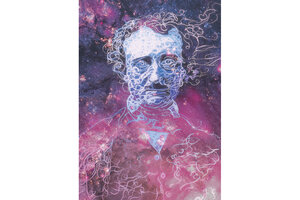Edgar Allan Poe exposed scientific hoaxes, and invented his own
A new Poe biography by John Tresch shows the writer’s deep involvement in the scientific milieu of his day.

Jacob Turcotte/Staff
Readers of Edgar Allan Poe’s most famous prose and poetry might be unaware of how often he wrote about science. As John Tresch explains in “The Reason for the Darkness of the Night: Edgar Allan Poe and the Forging of American Science,” in the late 1840s, near the end of his life, Poe had established for himself “a unique position as fiction writer, poet, critic, and expert on scientific matters – crossing paths with and learning from those who were producing the ‘apparent miracles’ of modern science.”
Poe exposed pseudoscientific hoaxes – and then, to get his own writing noticed, created them himself. He finally received critical acclaim for his now-classic short stories, among them “The Tell-Tale Heart” (which Tresch describes as “an act of violent irrationality [detailed] in the language of scientific method”) and “The Raven” (which Poe himself proclaimed “the greatest poem that ever was written”).
Tresch has painted a full landscape of the journalism of the time, describing the conflicts between writers who made serious scientific observations and those eager to sensationalize or misrepresent new discoveries. “Poe saw his age’s many humbugs and its ‘men of science’ pushing for foolproof forms of scientific authority as secret partners,” writes Tresch. “Together they were establishing the modern matrix of entertainment and science, doubt and certainty. Those who successfully denounced the tricks of charlatans were precisely those with the skills to make themselves believed.”
Speculation and controversy were rife in the press. “In the 1830s and 1840s, the lines between legitimate science, political provocation, and crowd-pleasing quackery were exceedingly difficult to define,” he writes. His descriptions of the way the popular press blended news, entertainment, and hype will remind readers of the media landscape of present-day America, though Tresch himself refrains from explicit comparisons.
Poe was also deeply interested in formulating theories about the origins of the universe and the nature of God. Near the end of his life, he wrote a philosophical-scientific treatise called “Eureka,” which has, for reasons that Tresch makes clear, fallen into obscurity. Poe boasted to a friend that “Eureka” was destined to “revolutionize the world of Physical & Metaphysical Science,” but the result was something more confusing than revolutionary. The biographer labels it “a serious mess, a glorious mess, but a mess.”
While Tresch is more interested in exploring the scientific milieu in which Poe moved than in the scandals that dogged him, the book still chronicles the desperate arcs of Poe’s life.
Despite his success, Poe succumbed to the “perversity” that he believed was built into human nature: When the going got good, he began to sabotage himself. “One of the searing ironies of Poe’s life,” writes Tresch, “was that during this rise to fame, as he developed an ideal of the quasi-omniscient author in total control of the creative process, his life was falling apart – his career, his relationships, and his very mind – a victim of bad luck, alcohol, and self-sabotage.”
Tresch also relays criticisms of Poe that were made by his contemporaries. Nathaniel Hawthorne, for example, thought Poe’s short stories were “like the vagaries of an opium eater.” Even Poe’s critics, however, might agree with Tresch’s incisive assessment that Poe “telegraphed the fascinations and the terrors of simply being alive.”
It’s worth noting that Tresch has generated a fair amount of Poe apologia here. For example, he takes Poe’s complaints about his foster father, John Allan, at face value. And he attempts to explain away Poe’s marriage to his 13-year-old cousin by saying such a practice was not unusual – though Poe, who was 26, lied about her age to friends and officials. But even Tresch cringes over Poe’s strident denunciation of Longfellow’s abolitionist poetry as “incendiary drivel.”
In the end, the telltale heart of “The Reason for the Darkness of the Night” is this: “Poe’s fantastic tales, detective stories, and nonfiction writings dramatized the act of inquiry and the struggles, fears, hopes, and delusions of the human being undertaking it. His ... search for hidden causes places him at the center of the maelstrom of American science in the first half of the nineteenth century.” Tresch has produced a steady, clever, engaging literary biography that provides an excellent survey of an overlooked aspect of Poe’s writing.


